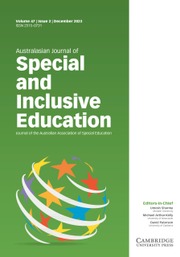Crossref Citations
This article has been cited by the following publications. This list is generated based on data provided by
Crossref.
Óskarsdóttir, Edda
Donnelly, Verity
Turner-Cmuchal, Marcella
and
Florian, Lani
2020.
Inclusive school leaders – their role in raising the achievement of all learners.
Journal of Educational Administration,
Vol. 58,
Issue. 5,
p.
521.
DeMatthews, David E.
Kotok, Stephen
and
Serafini, Amy
2020.
Leadership Preparation for Special Education and Inclusive Schools: Beliefs and Recommendations From Successful Principals.
Journal of Research on Leadership Education,
Vol. 15,
Issue. 4,
p.
303.
DeMatthews, David
2020.
Addressing Racism and Ableism in Schools: A DisCrit Leadership Framework for Principals.
The Clearing House: A Journal of Educational Strategies, Issues and Ideas,
Vol. 93,
Issue. 1,
p.
27.
Choi, Jeong Hoon
McCart, Amy B.
and
Sailor, Wayne
2020.
Achievement of Students With IEPs and Associated Relationships With an Inclusive MTSS Framework.
The Journal of Special Education,
Vol. 54,
Issue. 3,
p.
157.
McLeskey, James
2020.
Reflections on Future Directions for Including Students with Severe Disabilities.
Research and Practice for Persons with Severe Disabilities,
Vol. 45,
Issue. 1,
p.
45.
DeMatthews, David
2020.
Undoing systems of exclusion: exploring inclusive leadership and systems thinking in two inclusive elementary schools.
Journal of Educational Administration,
Vol. 59,
Issue. 1,
p.
5.
Vavilala, Mounika Prashanthi
Shukla, Tanu
and
Nirban, Virendra Singh
2021.
Development of School Learning Organisation Scale and its Validation in the Indian Context.
p.
203.
DeMatthews, David E.
Serafini, Amy
and
Watson, Terri N.
2021.
Leading Inclusive Schools: Principal Perceptions, Practices, and Challenges to Meaningful Change.
Educational Administration Quarterly,
Vol. 57,
Issue. 1,
p.
3.
Cook, Bryan G.
Tankersley, Melody
and
Landrum, Timothy J.
2021.
The Next Big Thing in Learning and Behavioral Disabilities.
p.
1.
Coviello, James
and
DeMatthews, David E.
2021.
Failure is not final: principals’ perspectives on creating inclusive schools for students with disabilities.
Journal of Educational Administration,
Vol. 59,
Issue. 4,
p.
514.
Scheer, David
2021.
Integrated framework model for the leadership role of principals in inclusive education.
European Journal of Education,
Vol. 56,
Issue. 4,
p.
660.
Duncan, Jill
and
Punch, Renee
2021.
Building Inclusive Education Workforce Capability: School Principals’ Perceptions of Roles and Responsibilities.
Australasian Journal of Special and Inclusive Education,
Vol. 45,
Issue. 1,
p.
62.
Ackah-Jnr, Francis R.
2022.
Enabling inclusive education: the leadership ecosystem in an early childhood-school-community context.
International Journal of Leadership in Education,
p.
1.
DeMatthews, David E.
and
Mueller, Carlyn
2022.
Principal Leadership for Inclusion: Supporting Positive Student Identity Development for Students with Disabilities.
Journal of Research on Leadership Education,
Vol. 17,
Issue. 4,
p.
315.
Veli Korkmaz, Ayfer
van Engen, Marloes L.
Knappert, Lena
and
Schalk, René
2022.
About and beyond leading uniqueness and belongingness: A systematic review of inclusive leadership research.
Human Resource Management Review,
Vol. 32,
Issue. 4,
p.
100894.
Hernández-González, Osvaldo
Spencer-Contreras, Rosario
Sanz-Cervera, Pilar
and
Tárraga-Mínguez, Raúl
2022.
Analysis of the Autism Spectrum Disorder (ASD) Knowledge of Cuban Teachers in Primary Schools and Preschools.
Education Sciences,
Vol. 12,
Issue. 4,
p.
284.
Emam, Mahmoud Mohamed
and
F. Hendawy Al-Mahdy, Yasser
2022.
Building School Capacity for Inclusive Education in the Sultanate of Oman: A Construct Validation of the Inclusive School Climate Scale.
Leadership and Policy in Schools,
Vol. 21,
Issue. 2,
p.
329.
Ketikidou, Georgia
and
Saiti, Anna
2022.
The promotion of inclusive education through sustainable and systemic leadership.
International Journal of Leadership in Education,
p.
1.
Melloy, Kristine J.
Cieminski, Amie
and
Sundeen, Todd
2022.
Accepting Educational Responsibility: Preparing Administrators to Lead Inclusive Schools.
Journal of Research on Leadership Education,
Vol. 17,
Issue. 4,
p.
358.
Sumbera, Becky Gail
Sparks, Shannon
Grabow, James
and
Quick, Austin Dylan
2022.
Rethinking Perception and Centering the Voices of Unique Individuals.
p.
1.


